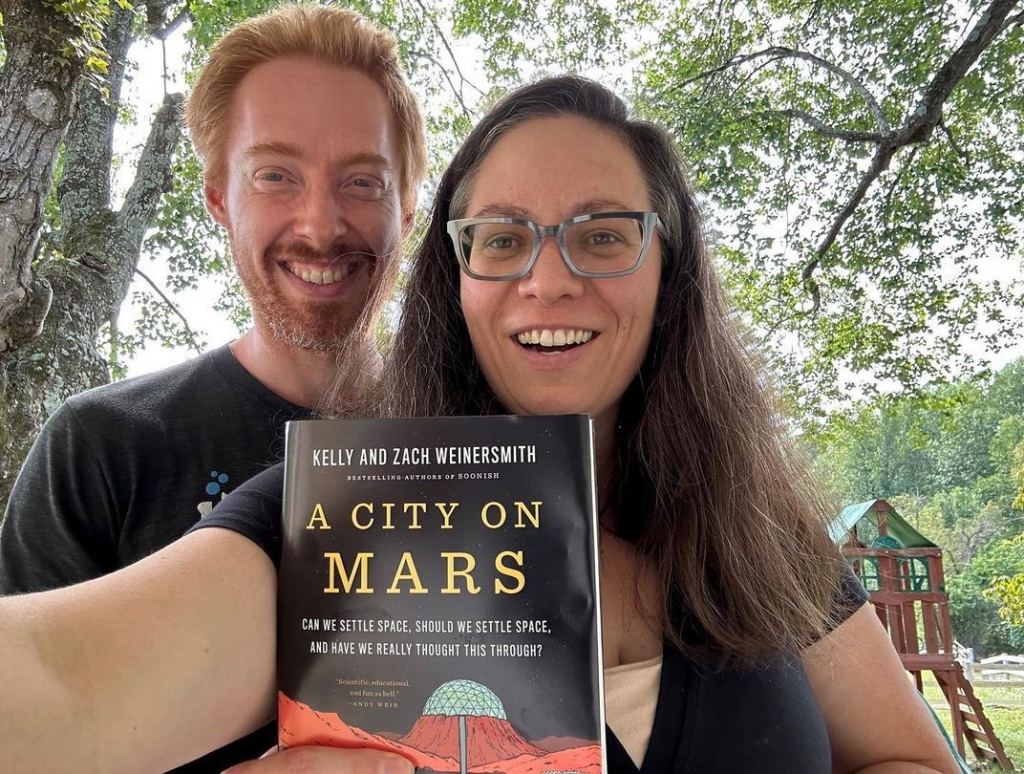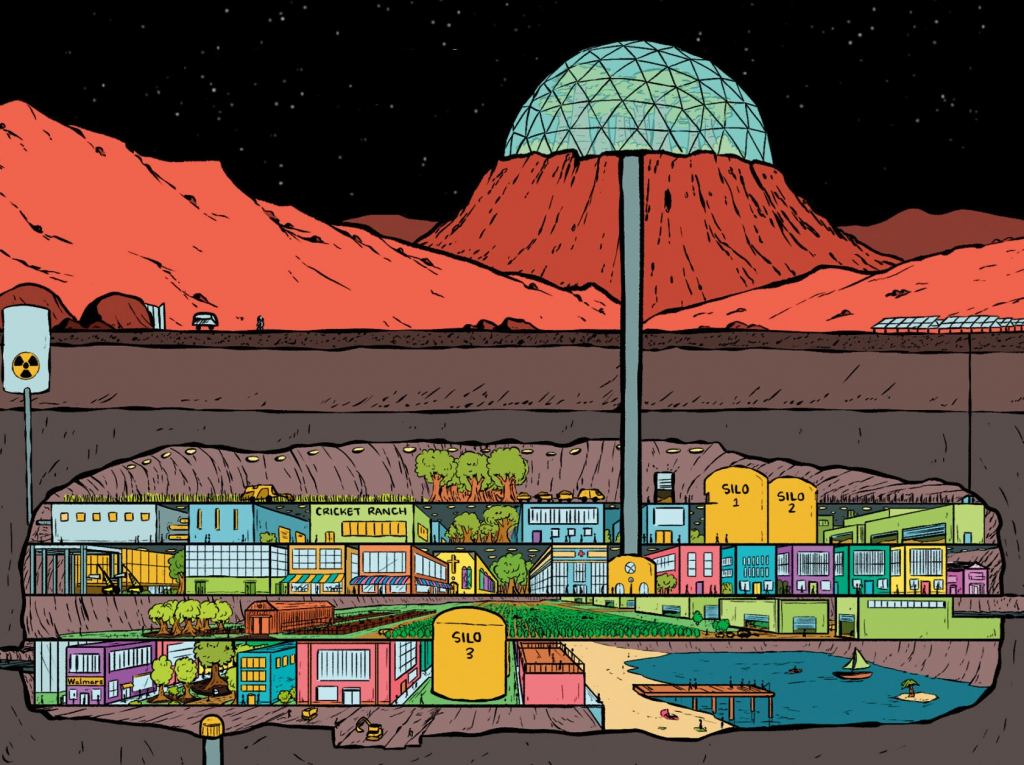Elon Musk and Jeff Bezos may harbor multibillion-dollar dreams of sending millions of people to live on Mars, on the moon and inside free-flying space habitats — but a newly published book provides a prudent piece of advice: Don't go too boldly.
It's advice that Kelly and Zach Weinersmith didn't expect they'd be giving when they began to work on their book, titled “A City on Mars.” They thought they'd be writing a guide to the golden age of space settlement that Musk and Bezos were promising.
"We ended up doing a ton of research on space settlements from just every angle you can imagine," Zach Weinersmith says in the latest episode of the Fiction Science podcast. "This was a four-year research project. And about two and a half years in, we went from being fairly optimistic about it as a desirable, near-term likely possibility [to] probably unlikely in the near term, and possibly undesirable in the near term. So it was quite a change. Slightly traumatic, I would say."
https://open.spotify.com/show/5rvWLp0jMAQuI66HisyLix
The Weinersmiths found that there was precious little research into the potential long-term health effects of living on the moon or Mars — and zero research into the potential effects on human reproduction and development. Moreover, the legal uncertainties surrounding property rights in space seemed likely to lead to disputes that would tie diplomats and military planners in knots.
"In our effort to create Mars settlements to make a Plan B, to make ourselves safer as a species, are we actually lowering existential risk?" Zach says. "I think it's absolutely unclear — and there's a good argument that we might even increase it."
The idea of creating settlements in space goes back decades: Cities on the moon served as settings for Robert Heinlein's “The Moon Is a Harsh Mistress” in 1966, and for Andy Weir's “Artemis” in 2018. Martian cities are featured in Kim Stanley Robinson's Mars Trilogy of the 1990s as well as in “2312,” published in, um, 2012. “The High Frontier,” written by physicist Gerard K. O'Neill, provided an in-depth description of life inside a giant space habitat back in 1976.
Space settlements have also starred in TV shows ranging from the 1970s prime-time series “Space: 1999” to “The Expanse,” “Mars” and “For All Mankind” (which is kicking off its fourth season this week).
The interest isn't totally fictional: Elon Musk says he hopes there’ll be a self-sustaining city on Mars in 20 years, and he's pledged his fortune to make it so. Bezos, meanwhile, says he's looking forward to the day when there's millions of people living and working in space, even if it takes hundreds of years to get there.
We already know that thousands of people are interested in going. When a Dutch venture called Mars One put out the call for applicants to sign up for a one-way trip to the Red Planet, more than 200,000 people expressed interest — and more than 2,700 were interested enough to pay an application fee.
That venture fizzled out, but space settlement proponents including Mars Society founder Robert Zubrin are keeping the dream alive. In September, Zubrin announced that a Mars Technology Institute would be established to develop the tools and processes that settlers would need. "It is hope, rather than greed, that will get us to Mars," he said.
Hope vs. hype
The husband-and-wife team behind "A City on Mars" bring an outsider's view to the space settlement issue. Kelly Weinersmith is a behavioral ecologist who focuses on the interplay between parasites and hosts. Zach Weinersmith is the cartoonist behind a geeky comic strip called “Saturday Morning Breakfast Cereal.”
In 2017, they published a book called “Soonish” that looked at emerging technologies including reusable rockets, space elevators and asteroid mining. They were struck by the fact that some technologies (for example, rocket reusability) came to fruition so quickly, while others (such as asteroid mining) were fraught with complications.
So what about space settlement? For four years, the Weinersmiths interviewed experts and sifted through research to see how close we've come to setting up space homes (“spomes?”) on the moon, Mars or elsewhere beyond Earth. In the resulting book, they pick apart the rationales that are commonly given for building space cities, and point out several key issues that would have to be addressed before humanity leaves its planetary cradle.
One issue has to do with the dearth of research into the health effects of long-term exposure to reduced gravity and space radiation — particularly relating to childbirth and child development. The Weinersmiths wrote a guest essay for The New York Times on the human reproduction issue, headlined "Space Billionaires Should Spend More Time Thinking About Sex."
"If you say we're going to have a million people on Mars in 30 years and you haven't done this science, then it's effectively something like experimenting on children, because there are a lot of a priori reasons to think it would be quite bad," Zach Weinersmith says. "In the best case, you'd expect an increased rate of abnormality."
Fortunately for those future children, some studies are now being done. Just last week, Japanese researchers reported that mouse embryos were able to progress into the early stages of cell development in zero-gravity conditions aboard the International Space Station. The experiment was hailed as “the first-ever study that shows mammals may be able to thrive in space” — and as one small step toward finding out whether mammals can give birth to normal progeny off-Earth.
It's not clear how long it would take to ensure the safety of humanity's giant leap to a multigenerational presence in space — but that's not the only obstacle space settlers will have to overcome. A hefty section of the book addresses the ins and outs of international law as they apply, or should apply, to property rights in space
In the 1960s, the United States and the Soviet Union were among signatories to the Outer Space Treaty, a Cold War agreement that ruled out claiming sovereignty over territory on the moon or other celestial bodies. Back then, the prospects for exploiting the moon's resources seemed largely theoretical, but when commercial space ventures began their rapid rise, policymakers began having second thoughts.
In 2015, the federal government established a law asserting that U.S. companies could extract resources from the moon, asteroids or other celestial bodies — while sidestepping sovereignty. Only a few other countries have gone that far, and the Weinersmiths are worried that a land grab in space could quickly spark a war on Earth.
"The international law is very conflict-prone," Zach says.
How to prepare for an off-Earth move
Will it ever be possible to create cities on Mars? The Weinersmiths propose a roadmap to get there, but it's not an easy or cheap ride.
"If you gave us a NASA-sized budget to solve the problems you need to solve for space settlement, a big piece of it ought to go to building sealed ecosystems on Earth," Zach says.
He envisions building a multitude of experimental closed-loop habitats, modeled after the Biosphere 2 facility that hosted a research crew for two years in the 1990s. Similar facilities have been set up elsewhere — including Lunar Palace in China and MELiSSA in Spain — but Zach says such efforts have to be revved up to the next level.
"If I was running a space settlement preparation agency, what you'd want to do is build a lot of these systems, maybe make them smaller than Biosphere and modular so you can see how small you can take it, [find out] what are the best plants, bacteria, animals, et cetera, and really develop a science," he said. "We don't have it. And you really have to have it to do Mars."
As to the legal issues, the Weinersmiths say the rights and responsibilities relating to space settlements — including the right to extract resources — should be negotiated internationally. They point to the process that led to the establishment of the International Seabed Authority as a model to follow.
If Earth were headed for an unavoidable catastrophe, could the groundwork for a city in space be completed in 20 years? Maybe.
"Honestly, if you felt like you had to do it in 20 years, I don't want to say it would be hopeless, but it would be genuinely horrific, because you would end up in a situation probably where most people couldn't go, and you'd have to prioritize," Zach Weinersmith says. "There might be serious problems lurking beyond some time barrier that we don't know about, that would prevent them from developing into full adults. And finding that out the hard way would be horrific."
But would that kind of trip to the moon or Mars be necessary? Almost certainly not, according to the Weinersmiths.
"There's tons of awesome science," Zach says. "I would just absolutely kill for someone to send a robot into the lava tubes. That sounds like the most amazing thing in the solar system. But in terms of making money, all the cases are really questionable. … There's really no reason to fight over anything on the moon. It's just a place that should be like Antarctica, where we do science and we cooperate and we learn stuff."
Check out the original version of this posting on Cosmic Log to get Zach Weinersmith's recommendations for further reading on space settlements.
The co-host for the Fiction Science podcast is Dominica Phetteplace, an award-winning writer who is a graduate of the Clarion West Writers Workshop and currently lives in San Francisco. To learn more about Phetteplace, visit her website, DominicaPhetteplace.com, and read an excerpt from “The Ghosts of Mars,” her novella in the current issue of Asimov’s Science Fiction magazine.
Stay tuned for future episodes of the Fiction Science podcast via Apple, Google, Overcast, Spotify, Player.fm, Pocket Casts and Radio Public. If you like Fiction Science, please rate the podcast and subscribe to get alerts for future episodes.
 Universe Today
Universe Today


